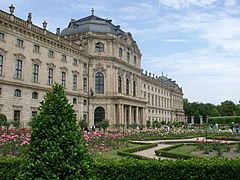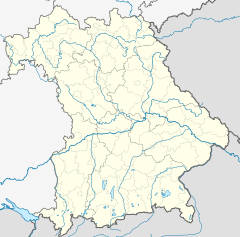Würzburg Residenz
| Würzburg Residence | |
|---|---|
| Würzburger Residenz | |

The garden front of Würzburg Residence
|
|
| General information | |
| Type | Palace |
| Architectural style | Baroque |
| Location | Würzburg |
| Country | Germany |
| Groundbreaking | 1720 |
| Completed | 1744 (main structure) 1780 (interiors) |
| Owner | Bavarian Administration of State-Owned Palaces, Gardens and Lakes |
| Website | |
| Residence page at Bavarian Administration of State-Owned Palaces, Gardens and Lakes | |
| UNESCO World Heritage Site | |
| Includes | Ceiling fresco in the staircase of the Würzburg Residence |
| Criteria | Cultural: (i), (iv) |
| Reference | 169 |
| Inscription | 1981 (5th Session) |
|
[]
|
|
The Würzburg Residence (German: Würzburger Residenz) is a palace in Würzburg, Germany. Johann Lukas von Hildebrandt and Maximilian von Welsch, representatives of the Austrian/South German Baroque style, were involved in the construction, as well as Robert de Cotte and Germain Boffrand, who were followers of the French Style. Balthasar Neumann, court architect of the Bishop of Würzburg, was the principal architect of the Residence, which was commissioned by the Prince-Bishop of Würzburg Johann Philipp Franz von Schönborn and his brother Friedrich Carl von Schönborn in 1720, and completed in 1744. The Venetian painter Giovanni Battista Tiepolo, assisted by his son, Domenico, painted frescoes in the building.
Interiors considered masterworks of Baroque/Rococo or Neoclassical architecture and art include the grand staircase, the chapel, and the Imperial Hall. The building was reportedly called the "largest parsonage in Europe" by Napoleon. It was heavily damaged during World War II, and restoration has been in progress since 1945. Since 1981, the Residence has been a UNESCO World Heritage Site.
The Prince-Bishops of Würzburg resided in the Marienberg Fortress on a hill west of the Main river until the early 18th century. Johann Philipp Franz von Schönborn (1719–24) moved the court to a palace erected in 1701–4, the predecessor of the Residence. However, the rather small palace did not, in his opinion, measure up to his position as an absolute monarch - he was looking for something comparable to the Palace of Versailles or Schönbrunn Palace. Having won a sum of 600,000 fl. (a fortune at the time) in a court case in the year of his accession, he used the funds to undertake a building project that would proclaim his political standing to all.
...
Wikipedia

